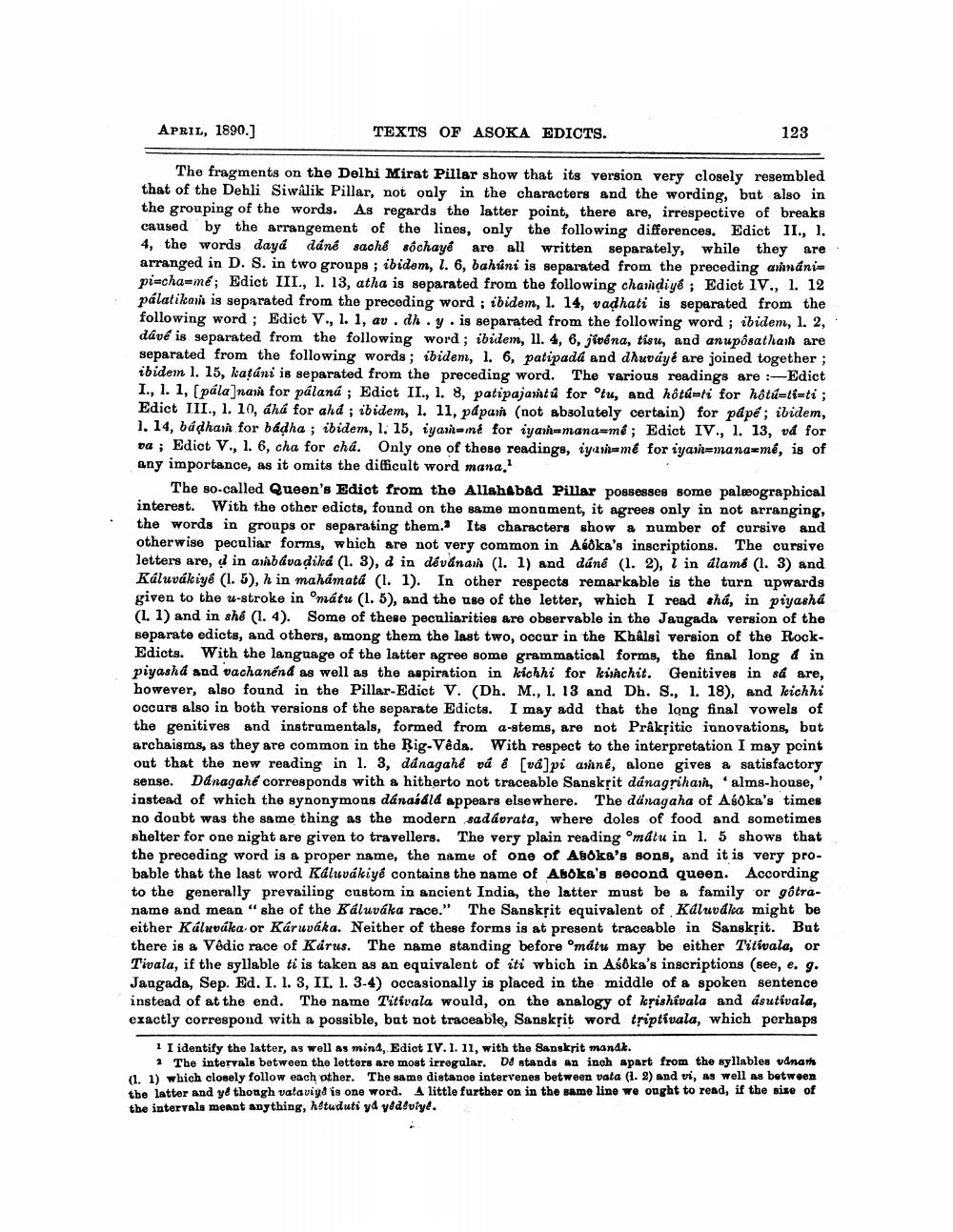________________
APRIL, 1890.]
TEXTS OF ASOKA EDICTS.
The fragments on the Delhi Mirat Pillar show that its version very closely resembled that of the Dehli Siwâlik Pillar, not only in the characters and the wording, but also in the grouping of the words. As regards the latter point, there are, irrespective of breaks caused by the arrangement of the lines, only the following differences. Edict II., 1. 4, the words dayá dáné saché sochayé are all written separately, while they are arranged in D. S. in two groups; ibidem, l. 6, bahuni is separated from the preceding amnanipi-cha-mé; Edict III., 1. 13, atha is separated from the following chamdiyé; Edict 1V., 1. 12 pálatikam is separated from the preceding word; ibidem, 1. 14, vadhati is separated from the following word; Edict V., 1. 1, av. dh. y. is separated from the following word; ibidem, 1. 2, dávé is separated from the following word; ibidem, 11. 4, 6, jivéna, tisu, and anupôsatham are separated from the following words; ibidem, 1. 6, patipadá and dhuváyé are joined together; ibidem 1. 15, katáni is separated from the preceding word. The various readings are :-Edict I., 1. 1, [pala]nam for pálaná; Edict II., 1. 8, patipajamtú for tu, and hôtú-ti for hôtú-ti-ti; Edict III., 1. 10, áhá for ahd; ibidem, 1. 11, pápain (not absolutely certain) for pápé; ibidem, 1. 14, bádham for bádha; ibidem, 1. 15, iyah-mé for iyam mana-mé; Edict IV., 1. 13, vá for va; Edict V., 1. 6, cha for chá. Only one of these readings, iyam-mé for iyam-mana-mé, is of any importance, as it omits the difficult word mana.1
123
The so-called Queen's Edict from the Allahabad Pillar possesses some palæographical interest. With the other edicts, found on the same monument, it agrees only in not arranging, the words in groups or separating them. Its characters show a number of cursive and otherwise peculiar forms, which are not very common in Aéôka's inscriptions. The cursive letters are, d in ambávaḍiká (1. 3), d in dévána (1. 1) and dúné (1. 2), l in alamé (1. 3) and Káluvákiyé (1. 5), h in mahámatá (1. 1). In other respects remarkable is the turn upwards given to the u-stroke in mátu (1. 5), and the use of the letter, which I read shá, in piyashá (1.1) and in she (1.4). Some of these peculiarities are observable in the Jaugada version of the separate edicts, and others, among them the last two, occur in the Khâlsi version of the RockEdicts. With the language of the latter agree some grammatical forms, the final long á in piyasha and vachanénd as well as the aspiration in kichhi for kichit. Genitives in sá are, however, also found in the Pillar-Edict V. (Dh. M., 1. 13 and Dh. S., 1. 18), and kichhi occurs also in both versions of the separate Edicts. I may add that the long final vowels of the genitives and instrumentals, formed from a-stems, are not Prâkritic innovations, but archaisms, as they are common in the Rig-Vêda. With respect to the interpretation I may point out that the new reading in 1. 3, dánagahé vá é [vá]pi amné, alone gives a satisfactory sense. Dánagahé corresponds with a hitherto not traceable Sanskrit dánagrihamn, alms-house, instead of which the synonymous dánaśálá appears elsewhere. The danagaha of Aśoka's times no doubt was the same thing as the modern sadávrata, where doles of food and sometimes shelter for one night are given to travellers. The very plain reading matu in 1. 5 shows that the preceding word is a proper name, the name of one of Asoka's sons, and it is very probable that the last word Káluvákiyé contains the name of Asoka's second queen. According to the generally prevailing custom in ancient India, the latter must be a family or gôtraname and mean "she of the Káluváka race." The Sanskrit equivalent of Kaluváka might be either Káluváka or Kúruváka. Neither of these forms is at present traceable in Sanskrit. But there is a Vêdic race of Kárus. The name standing before 'mátu may be either Titivala, or Tivala, if the syllable ti is taken as an equivalent of iti which in Aśoka's inscriptions (see, e. g. Jangada, Sep. Ed. I. 1. 3, II. 1. 3-4) occasionally is placed in the middle of a spoken sentence instead of at the end. The name Titivala would, on the analogy of krishivala and ásutivala, exactly correspond with a possible, but not traceable, Sanskrit word triptívala, which perhaps
1 I identify the latter, as well as mind, Edict IV. 1. 11, with the Sanskrit manak.
2 The intervals between the letters are most irregular. De stands an inch apart from the syllables vanam (1. 1) which closely follow each other. The same distance intervenes between vata (1. 2) and vi, as well as between the latter and ye though vataviyd is one word. A little further on in the same line we ought to read, if the size of the intervals meant anything, hétuduti ya yêdêviye..




